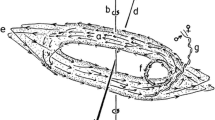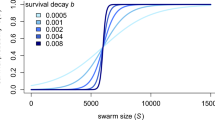Abstract
When colonies of swarm-founding wasps lose their nests to predation or accident, the entire adult population escapes, emigrates as an absconding swarm, and renests elsewhere. Such an event causes a reduction in the adult population due to losses during the emigration itself and to adult attrition without replacement during the subsequent preemergence growth period in the new nest. We addressed the first of these sources of mortality for 27 absconding swarms of Polybia occidentalis in Costa Rica. Adult mortality over the day that included swarm emigration averaged 0.044 ± 0.039 (SD) of the original population and was a weak positive function of distance moved, but not of swarm size. A larger data set showed that emigration distance increased with swarm size. This is the first study to measure mortality rates during emigration in a swarm-founding social insect.
Similar content being viewed by others
REFERENCES
Bouwma, P. E., Bouwma, A. M., and Jeanne, R. L. (2000). Social wasp swarm emigration: Males stay behind. Ethol. Ecol. Evol. 12: 35–42.
Bouwma, A. M., Bouwma, P. E., Nordheim, E. V., and Jeanne, R. L. (2003). Adult mortality rates in young colonies of a swarm-founding social wasp. J. Zoo. 260: 11–16.
Chadab, R. (1979a). Early warning cues for social wasps attacked by army ants. Psyche 86: 115–123.
Chadab, R. (1979b). Army-Ant Predation on Social Wasps, Ph.D. thesis, University of Connecticut, Storrs.
Ezenwa, V. O., Henshaw, M. T., Queller, D. C., and Strassmann, J. E. (1998). Patterns of buzz running, pre-swarming behavior, in the Neotropical wasp Parachartergus colobopterus. Insectes Soc. 45: 445–456.
Forsyth, A. B. (1978). Studies on the Behavioral Ecology of Polygynous Social Wasps, Ph.D. thesis, Harvard University, Cambridge, MA.
Forsyth, A. B. (1981). Swarming activity of polybiine social wasps (Hymenoptera: Vespidae: Polybiini). Biotropica 13: 93–99.
Gadagkar, R. (1990). Evolution of eusociality: The advantage of assured fitness returns. Phil. Trans. R. Soc. London B 329: 17–25.
Hölldobler, B., and Wilson, E. O. (1977). The number of queens: An important trait in ant evolution. Naturwissenschaften 64: 8–15.
Hölldobler, B., and Wilson, E. O. (1990). The Ants, Harvard University Press, Cambridge, MA.
Jeanne, R. L. (1972). Social biology of the Neotropical wasp: Mischocyttarus drewseni Bull. Mus. Comp. Zool. Harvard Univ. 144: 63–150.
Jeanne, R. L. (1975). Behavior during swarm movement in Stelopolybia areata (Hymenoptera: Vespidae). Psyche 82: 259–264.
Jeanne, R. L. (1981). Chemical communication during swarm emigration in the social wasp Polybia sericea (Olivier). Anim. Behav. 29: 102–113.
Jeanne, R. L. (1991). The swarm-founding Polistinae. In Ross, K. G., and Matthews, R. W. (Eds.), The Social Biology of Wasps, Comstock, Ithaca, NY, pp. 191–231.
Jeanne, R. L., and Nordheim, E. V. (1996). Productivity in a social wasp: Per capita output increases with swarm size. Behav. Ecol. 7: 43–48.
Matsuura, M., and Yamane, Sk. (1990). Biology of the Vespine Wasps, Springer-Verlag: New York.
Naumann, M. G. (1975). Swarming behavior: Evidence for communication in social wasps. Science 189: 642–644.
O'Donnell, S. (1992). Time-sharing, drifting, and pilfering: inter-nest activities of Polybia occidentalis foragers. Sphecos 23: 4.
O'Donnell, S., and Jeanne, R. L. (1992). Lifelong patterns of forager behaviour in a tropical swarm-founding wasp: Effects of specialization and activity level on longevity. Anim. Behav. 44: 1021–1027.
Queller, H. D. (1989). The evolution of eusociality: Reproductive head starts of workers. Proc. Natl. Acad. Sci. USA 86: 3224–3226.
Richards, O. W. (1978). The Social Wasps of the Americas, Excluding the Vespinae, British Museum (Natural History), London.
Simões, D., and Zucchi, R. (1980). Bionomics of Protopolybia exigua exigua (De Saussure) I—Age polyethism and life-table. (Hymenoptera, Vespidae, Polybiini). Naturalia 5: 79–87.
Solís, C. R., Hughes, C. R., Klingler, C. J., Strassmann, J. E., and Queller, D. C. (1998). Lack of kin discrimination during wasp colony fission. Behav. Ecol. 9(2): 172–176.
Strassmann, J. E. (1985). Worker mortality and the evolution of castes in the social wasp, Polistes exclamans. Insectes Soc. 32: 275–285.
Strassmann, J. E., Solis, C. R., Hughes, C. R., Goodninght, K. F., and Queller, D. C. (1997). Colony life history and demography of a swarm-founding social wasp. Behav. Ecol. Sociobiol. 40: 71–77.
Tosi, J. A., Jr. (1969). Ecological Map of Costa Rica, Tropical Science Center, San José, C.R.
Weisburg, S. (1985). Applied Linear Regression, 2nd ed. Wiley, New York.
West-Eberhard, M. J. (1982). The nature and evolution of swarming in tropical social wasps (Vespidae, Polistinae, Polybiini). In jaisson, P. (ed.), Social Insects in the Tropics, Université de Paris-Nord, Paris, pp. 97–128.
Winston, M. L., Otis, G. W., and Taylor, O. R. (1979). Absconding behavior of the Africanized honeybee in South America. J. Apic. Res. 18: 85–94.
Woyke, J. (1976). Brood rearing efficiency and absconding in Indian honeybees. J. Apic. Res. 15: 133–143.
Author information
Authors and Affiliations
Rights and permissions
About this article
Cite this article
Bouwma, A.M., Bouwma, P.E., Nordheim, E.V. et al. Founding Swarms in a Tropical Social Wasp: Adult Mortality, Emigration Distance, and Swarm Size. Journal of Insect Behavior 16, 439–452 (2003). https://doi.org/10.1023/A:1024836327936
Issue Date:
DOI: https://doi.org/10.1023/A:1024836327936




